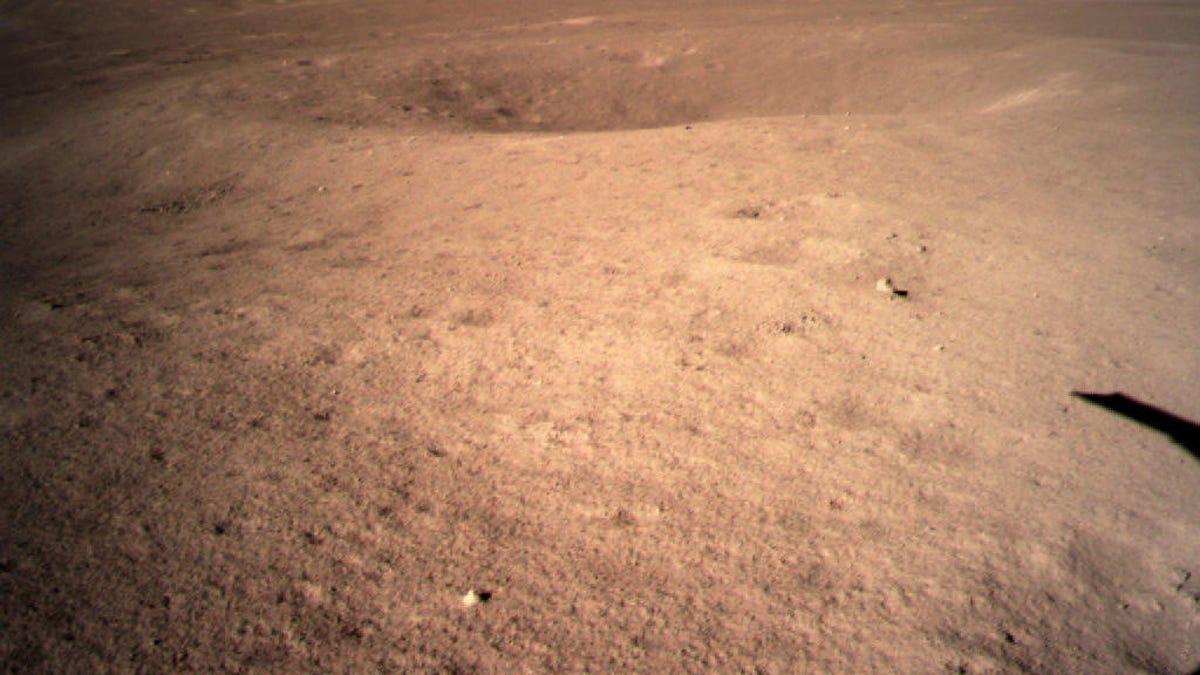China's Chang'e 4 sends back first photos of moon's far side after historic landing
Going where no spacecraft has gone before, Chang'e 4 snaps photos on the surface on the far side of the moon.

This is the first image of the moon's far side, taken by China's Chang'e 4 probe.
Humans have landed a spacecraft on the far side of the moon for the first time in history.
China's Chang'e 4 spacecraft achieved the milestone at 10:26 a.m. on Jan. 3 in Beijing (6:26 p.m. PT on Jan. 2), with the country's space agency landing its lunar probe in Von Karman crater on the moon's mysterious far side. Official word was provided at 12 p.m. local time (8 p.m. PT) by Chinese state media service CCTV.
Chang'e 4 sent back the first photo of the lunar surface a few hours later, via the relay satellite Queqiao (Magpie Bridge), according to the state-run China Global Television Network.
The Chang'e lander brought a rover with it to the moon.
Launched on Dec. 7, the Chang'e 4 craft comprises both a lunar lander and a six-wheeled rover. The spacecraft entered lunar orbit on Dec. 12 before preparations for landing nudged the spacecraft into an elliptical lunar orbit, getting as close as 15 kilometers (around 9 miles) from the surface.
Unlike NASA 's history-making mission to Mars in November and the agency's flyby of the mysterious Kuiper Belt Object 2014 MU69 on New Year's Day, China's landmark landing wasn't televised. Social media accounts on Chinese giant Weibo reported that the lunar probe touched down at around 6:26 p.m. PT, but confirmation of the reports was hard to come by. After tweets by Chinese state-owned media outlets China Daily and China Global Television Network made their way online, the Twittersphere was abuzz... but the tweets were quickly deleted.
The then-deleted confirmation of #ChangE4's touchdown reached Weibo in no time, and folks are confused.
— YE Quanzhi (@Yeqzids) January 3, 2019
Well maybe they are just waiting for someone to officially open the floodgate? Just like in any opening ceremony you need someone to cut that ribbon. pic.twitter.com/cdCibk7J4y
According to Andrew Jones, a journalist reporting on the Chinese space program, Chang'e 4's descent required "laser ranging and optical cameras for navigation, velocity and coarse hazard avoidance." Practically, this meant Chang'e 4 was on its own as it descended to the surface with its important scientific payload, on a side of the moon marked by rugged terrain.
Navigating to the far side poses a unique communications challenge. Sometimes known as the "dark side" of the moon, even though it does receive sunlight, the far side never faces the Earth because of tidal locking. That means budding human (or robot) explorers have to find a way to establish and maintain radio contact.
The probe also sent back images taken during the landing process.
To communicate with the Chang'e 4 mission on the moon's surface, the Chinese space agency launched the Queqiao relay satellite into a halo orbit over the dark side of the moon in May. The satellite overcomes the communications challenge, allowing the lander and rover to phone home, via relay, and send scientific data back.
Both the rover and the lander are equipped with a suite of instruments that will allow the Chinese space agency to study the geology of Von Karman crater, including three cameras.
The ancient crater, part of the 13-kilometer-deep South Pole-Aitken (SPA) Basin, is believed to hold material kicked up from deep within the lunar soil due to an impact early on in the moon's life, providing new insights on what makes up its interior. The lander also carries seeds and silkworm eggs within a sealed container and will examine whether the two lifeforms can thrive on the moon.
Chang'e 4's intended landing spot is the Von Kármán crater, an ancient impact crater around 186 kilometers in diameter.
Other instruments, developed by Swedish and German engineers, will allow the lunar robots to better study solar wind, charged particles that burst forth from the sun's atmosphere. Payloads were also provided by partners in the Netherlands and Saudi Arabia.
The last lander on the moon was Chang'e 4's predecessor, Chang'e 3, which soft-landed in a crater known as the Mare Imbrium in December 2013. In January 2014, the rover underwent a mechanical control abnormality and ceased to transmit data in March 2015. However, the lander remains on the near side of the moon.
Fifty years after NASA astronauts Neil Armstrong and Buzz Aldrin set foot on the lunar surface, the moon really is the place to be in 2019 with various international space agencies are ready to explore Earth's only natural satellite. Chang'e 4's mission is slated to last a year, but a subsequent lunar exploration mission -- Chang'e 5 -- is scheduled to launch toward the end of the year. If successful, it would be the first mission to the moon to return samples since Luna 24 in 1976.
CNET's Sean Keane contributed to this report.
First published on Jan. 2 at 8:05 p.m. PT.
Update, Jan. 3 at 3:02 a.m. PT: Adds first photos from lunar surface.
NASA turns 60: The space agency has taken humanity farther than anyone else, and it has plans to go further.
Taking It to Extremes: Mix insane situations -- erupting volcanoes, nuclear meltdowns, 30-foot waves -- with everyday tech. Here's what happens.

